X

Guidelines Home
Additional Information:
Links:

California Fertilization Guidelines
Processing Tomatoes

Javascript is disabled on your browser. For full functionality of this site it is necessary to enable JavaScript. Follow this link for instructions on how to enable JavaScript in your web browser.
Preplant
Sowing /
Transplanting
Transplanting
Vegetative
Growth
Growth
Bloom
Early
Fruit Set
Fruit Set
First Red
Fruits
Fruits
TOP OF PAGE
References:
Nitrogen
- de C. Carmello, Q.A., Anti G.R., 2006. Accumulation of nutrients and growth of processing tomato. Acta Horticulturae 724, 85-90.Elia, A., Conversa, G., 2012. Agronomic and physiological responses of a tomato crop to nitrogen input. European Journal of Agronomy 40, 64-74.
- Elia, A., Conversa, G., 2012. Agronomic and physiological responses of a tomato crop to nitrogen input. European Journal of Agronomy 40, 64-74.
- Geisseler D., Aegerter, B.J., Miyao, E.M., Turini, T., Cahn M.D., 2020. Nitrogen in soil and subsurface drip-irrigated processing tomato plants (Solanum lycopersicum L.) as affected by fertilization level. Scientia Horticulturae 261, 108999.
- Hammami, M., Daghari, H., 2007. Tomato root’s distribution and water uptake: contribution for trickle irrigation management. Acta Horticulturae 758, 227-234.
- Hartz, T.K, Bottoms, T.G., 2009. Nitrogen requirements of drip-irrigated processing tomatoes. HortScience 44, 1988–1993.
- Hartz, T.K., Hanson, B., 2009. Drip irrigation and fertigation management of processing tomato . University of California Vegetable Research and Information Center.
- Hartz, T.K., Miyao, E.M, Valencia, J.G., 1998. DRIS evaluation of the nutritional status of processing tomato. HortScience 33, 830-832.
- Hartz, T.K., Giannini, C., Miyao, E.M., Valencia, J.G., 2002. Divergent transplant production practices produce comparable growth, yield, and quality of processing tomatoes. HortScience 37, 296-299.
- Jones Jr., J.B., 2008. Tomato Plant Culture in the Field, Greenhouse and Home Garden. CRC Press, Boca Raton, FL.
- Krueskopf, H.H., Mitchell, J.P., Hartz, T.K., May, D.M., Miyao, E.M., Cahn, M.D., 2002. Presidedress soil nitrate testing identifies processing tomato fields not requiring sidedress N fertilizer. HortScience 37, 520-524.
- Lorenz, O.A., Tyler, K.B., 1976. Plant tissue analysis of vegetable crops. In: Reisenauer, H.M. (Ed.). Soil and Plant-Tissue Testing in California. University of California, Division of Agricultural Sciences, Bulletin 1879. pp. 24-29.
- Machado, R.M.A., Oliveira, M.R.G., 2005. Tomato root distribution, yield and fruit quality under different subsurface drip irrigation regimes and depths. Irrigation Science 24, 15–24.
- May, D., Mitchell, J., 2001. Soil testing to optimize nitrogen management for processing tomatoes. FREP Final Report.
- Maynard, D.N., Hochmuth, G.J., 2007. Knott’s Handbook for Vegetable Growers. John Wiley & Sons, Inc., Hoboken, NJ.
- Miyao, G., 2002. Fertilizer guidelines for processing tomatoes. Vegetable Crop Facts Merced and Madera County.
- Tan, X.W., Ikeda, H., Oda, M., 1999. Absorption, translocation, and assimilation of foliar-applied urea compared with nitrate and ammonium in tomato plants. Soil Science and Plant Nutrition 45, 609-616.
- Wittwer, S.H., Bukavac, M.J., Tuckey, H.B., 1963. Advances in foliar feeding of plant nutrients. In: McVickar, M.H., Bridger, G.L., Nelson, L.B. (Eds.). Fertilizer Technology and Usage. Soil Science Society of America, Madison, WI. pp. 429-455.
- Wilcox, G.E., 1993. Tomato. In: Bennett, W.F. (Ed.). Nutrient Deficiencies and Toxicities in Crop Plants. APS Press, St. Paul, MN. pp. 137-141.
Phosphorus
- Bergmann, W., 1992. Nutritional Disorders of Plants: Development, Visual and Analytical Diagnosis. Gustav Fischer Verlag, New York.
- Blatt, C.R., McRae, K.B., 1986. Effect of irrigation and nitrogen, phosphorus and potassium rate and placement on tomato fruit yield and size. Canadian Journal of Soil Science 66, 653-660.
- Chrsitou, M., Dumas, Y., Dimirkou, A., Vassiliou, Z., 1999. Nutrient uptake by processing tomato in Greece. Acta Horticulturae 487, 219-223.
- de C. Carmello, Q.A., Anti G.R., 2006. Accumulation of nutrients and growth of processing tomato. Acta Horticulturae 724, 85-90.
- Grubinger, V.P., Minotti, P.L., Wien, H.C., Turneti A.D., 1993. Tomato response to starter fertilizer, polyethylene mulch, and level of soil phosphorus. Journal of the American Society for Horticultural Science 118, 212-216.
- Hammami, M., Daghari, H., 2007. Tomato root’s distribution and water uptake: contribution for trickle irrigation management. Acta Horticulturae 758, 227-234.
- Hartz, T., 2008. Efficient fertigation management for drip-irrigated processing tomatoes. UCCE Vegetable Notes Fresno, Tulare and Kings Counties 4, 2-3.
- Hartz, T.K, Bottoms, T.G., 2009. Nitrogen requirements of drip-irrigated processing tomatoes. HortScience 44, 1988–1993.
- Hartz, T.K., Hanson, B., 2009. Drip irrigation and fertigation management of processing tomato . University of California Vegetable Research and Information Center.
- Hartz, T.K., Miyao, E.M, Valencia, J.G., 1998. DRIS evaluation of the nutritional status of processing tomato. HortScience 33, 830-832.
- Hartz, T.K., Giannini, C., Miyao, E.M., Valencia, J.G., 2002. Divergent transplant production practices produce comparable growth, yield, and quality of processing tomatoes. HortScience 37, 296-299.
- Hartz, T.K., Miyao, G., Mickler, J., LeStrange, M., Stoddard, S., Nunez, J., Aegerter B., 2008. Processing tomato production in California. University of California Publication 7228.
- Hipp, B.W., 1970. Phosphorus requirements for tomatoes as influenced by placement. Agronomy Journal 62, 203-206.
- Jones Jr., J.B., 1998. Phosphorus toxicity in tomato plants: when and how does it occur? Communications in Soil Science and Plant Analysis 29, 1779-1784.
- Jones Jr., J.B., 2008. Tomato Plant Culture in the Field, Greenhouse and Home Garden. CRC Press, Boca Raton, FL.
- Lorenz, O.A., Tyler, K.B., 1976. Plant tissue analysis of vegetable crops. In: Reisenauer, H.M. (Ed.). Soil and Plant-Tissue Testing in California. University of California, Division of Agricultural Sciences, Bulletin 1879. pp. 24-29.
- Machado, R.M.A., Oliveira, M.R.G., 2005. Tomato root distribution, yield and fruit quality under different subsurface drip irrigation regimes and depths. Irrigation Science 24, 15–24.
- Maynard, D.N., Hochmuth, G.J., 2007. Knott’s Handbook for Vegetable Growers. John Wiley & Sons, Inc., Hoboken, NJ.
- Miyao, G., 2002. Fertilizer guidelines for processing tomatoes. Vegetable Crop Facts Merced and Madera County .
- Mortley, D.G., Smith, C.B., Demchak, K.T., 1991. Fertilizer placement affects growth, fruit yield, and elemental concentrations and contents of tomato plants. Journal of the American Society for Horticultural Science 116, 659-662.
- UC IPM (University of California Statewide Integrated Pest Management Program), 2011. Fertilization. In: University of California Agriculture and Natural Resources (Ed.). Pest Management Guidelines: Tomato. Publication 3470. pp. 5-7.
- Wilcox, G.E., 1993. Tomato. In: Bennett, W.F. (Ed.). Nutrient Deficiencies and Toxicities in Crop Plants. APS Press, St. Paul, MN. pp. 137-141.
Potassium
- California Plant Health Association, 2002. Western Fertilizer Handbook 9th edition. Interstate Publishers, Inc.
- Csizinszky, A., 1999. Yield response of polyethylene mulched tomato to potassium source and rate on sand, Journal of Plant Nutrition 22, 669-678.
- Hammami, M., Daghari, H., 2007. Tomato root’s distribution and water uptake: contribution for trickle irrigation management. Acta Horticulturae 758, 227-234.
- Hartz, T., 2002. Potassium requirements for processing tomatoes. Vegetable Crop Facts Merced and Madera County .
- Hartz, T., 2008. Efficient fertigation management for drip-irrigated processing tomatoes. UCCE Vegetable Notes Fresno, Tulare and Kings Counties 4, 2-3.
- Hartz, T.K, Bottoms, T.G., 2009. Nitrogen requirements of drip-irrigated processing tomatoes. HortScience 44, 1988–1993.
- Hartz, T.K., Hanson, B., 2009. Drip irrigation and fertigation management of processing tomato . University of California Vegetable Research and Information Center.
- Hartz, T., Miyao, E.M., 2005. Potassium fertility management for optimum tomato yield and fruit color. FREP Final Report.
- Hartz, T.K., Miyao, E.M, Valencia, J.G., 1998. DRIS evaluation of the nutritional status of processing tomato. HortScience 33, 830-832.
- Hartz, T.K., Miyao, E.M., Mullen, R.J., Cahn, M.D., Valencia, J., Brittan, K.L., 1999. Potassium requirements for maximum yield and fruit quality of processing tomato. Journal of the American Society for Horticultural Science 124, 199–204.
- Hartz, T.K., Miyao, E.M., Mullen, R.J., Cahn, M.D., 2001. Potassium fertilization effects on processing tomato yield and fruit quality. Acta Horticulturae 542, 127-133.
- Hartz, T.K., Johnstone, P.R., Francis, D.M., Miyao, E.M., 2005. Processing tomato yield and fruit quality improved with potassium fertigation. HortScience 40, 1862-1867.
- Jackson, L.E., Bloom, A.J., 1990. Root distribution in relation to soil nitrogen availability in field-grown tomatoes. Plant and Soil 128, 115-126.
- Johnson Hake, S., Hake K.D., Kerby T.A., 1996. Prebloom decisions. In: Hake, S.J., Kerby T.A., Hake, K.D. (Eds.). Cotton Production Manual. University of California, Division of Agriculture and Natural Resources, Publication 3352. pp. 29-50.
- Jones Jr., J.B., 2008. Tomato Plant Culture in the Field, Greenhouse and Home Garden. CRC Press, Boca Raton, FL.
- K+S KALI GmbH. Chloride tolerance of various crops.
- Lorenz, O.A., Tyler, K.B., 1976. Plant tissue analysis of vegetable crops. In: Reisenauer, H.M. (Ed.). Soil and Plant-Tissue Testing in California. University of California, Division of Agricultural Sciences, Bulletin 1879. pp. 24-29.
- Maas, E.V., 1990. Crop salt tolerance. In: Tanji, K.K. (Ed.). Agricultural Salinity Assessment and Management Manual. ASCE, New York. pp. 262-304.
- Machado, R.M.A., Oliveira, M.R.G., 2005. Tomato root distribution, yield and fruit quality under different subsurface drip irrigation regimes and depths. Irrigation Science 24, 15–24.
- Maynard, D.N., Hochmuth, G.J., 2007. Knott’s Handbook for Vegetable Growers. John Wiley & Sons, Inc., Hoboken, NJ.
- Tanji, K.K., Kielen, N.C., 2002. Agricultural Drainage Water Management in Arid and Semi-Arid Areas. FAO Irrigation and Drainage Paper 61. FAO, Rome.
- UC IPM (University of California Statewide Integrated Pest Management Program), 2011. Fertilization. In: University of California Agriculture and Natural Resources (Ed.). Pest Management Guidelines: Tomato. Publication 3470. pp. 5-7.
- Wilcox, G.E., 1993. Tomato. In: Bennett, W.F. (Ed.). Nutrient Deficiencies and Toxicities in Crop Plants. APS Press, St. Paul, MN. pp. 137-141.
- Zhang, T.Q., Tan C.S., Liu K., 2009. Phosphorus and potassium application to processing tomatoes grown with drip irrigation. Acta Horticulturae 823, 97-102.



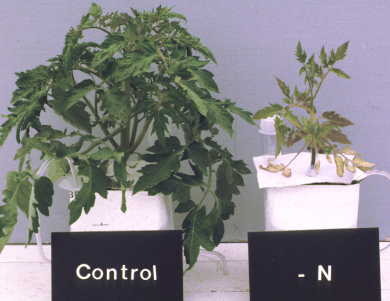 Hydroponic tomato plants supplied with all nutrients
(left) and with a nutrient solution deficient in N
(right; photo provided by Jim Richards, UC Davis).
Hydroponic tomato plants supplied with all nutrients
(left) and with a nutrient solution deficient in N
(right; photo provided by Jim Richards, UC Davis).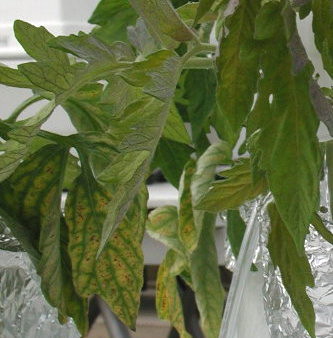

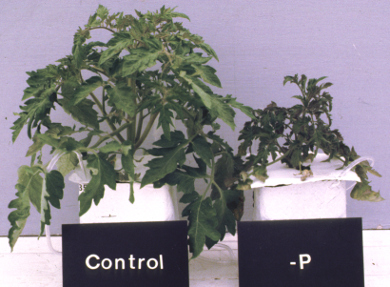 Hydroponic tomato plants supplied with all nutrients
(left) and with a nutrient solution deficient in P
(right; photo provided by Jim Richards, UC Davis).
Hydroponic tomato plants supplied with all nutrients
(left) and with a nutrient solution deficient in P
(right; photo provided by Jim Richards, UC Davis).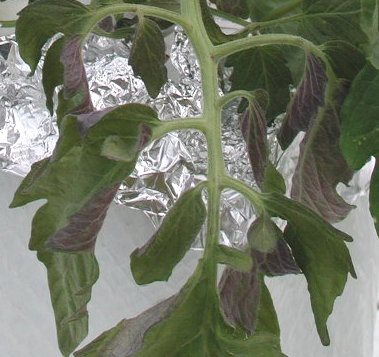

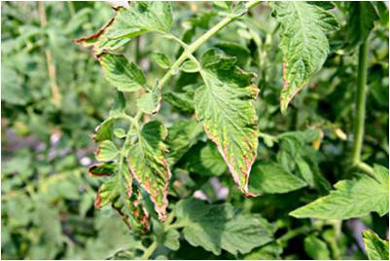 Potassium deficiency symptoms on
tomato leaves (photo provided by Eric Sideman, Maine Organic Farmers and Gardeners).
Potassium deficiency symptoms on
tomato leaves (photo provided by Eric Sideman, Maine Organic Farmers and Gardeners).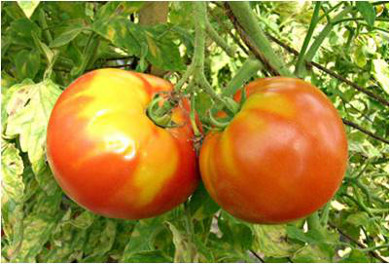 Yellow shoulder of tomatoes may be caused by K
deficiency (photo provided by Eric Sideman, Maine Organic Farmers and Gardeners).
Yellow shoulder of tomatoes may be caused by K
deficiency (photo provided by Eric Sideman, Maine Organic Farmers and Gardeners).